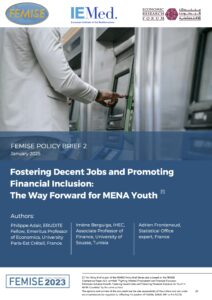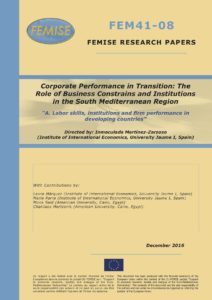
FEMISE is proud to launch its latest series of policy briefs, stemming from insightful conference papers presented at the FEMISE annual conference. These briefs are rooted in scientific research and offer actionable political recommendations to address critical challenges in the Euro-Mediterranean region.
The objective if this new series of Policy Briefs is to provide policy makers, international organisers, researchers and stakeholders in the EU-Med region with research-based policy recommendations that: advocate a better EU-Med integration; promote mobilization of investments towards green transition and sustainable economies; empower young people through innovation and entrepreneurship advocacy; and facilitate a better and more equal integration of youth and women, aiming to create pathways for decent employment.
These Policy Briefs aspires to drive impactful dialogue and action across the EU-Med region.
Contexte
This policy brief delves into the intertwined challenges of informal employment and financial exclusion that hinder inclusive growth in the MENA region. With youth unemployment rates among the highest globally—29% in North Africa and 25% in the rest of the region—and over 50% of young workers engaged in informal jobs lacking social protection, the need for targeted interventions is urgent. Additionally, two-thirds of MENA’s youth remain financially excluded, limiting their access to essential financial services and opportunities for entrepreneurship.
Focusing on Egypt, Jordan, and Tunisia, this policy brief investigates the root causes of these issues, using robust data analysis to identify trends in labor market dynamics and barriers to financial inclusion. It offers actionable recommendations, including fostering formal employment through education and vocational training, enhancing social protection, promoting gender equality, and leveraging fintech solutions. By addressing these challenges, the brief outlines a roadmap for empowering youth, driving economic resilience, and achieving sustainable development in the region.
 Resumé
Resumé
Informal employment (informality) and financial exclusion are linked and prove detrimental to inclusive growth. Informality is characterised by low productivity, which hampers growth and harms the welfare of workers. Financial exclusion slows down household savings and consumption, deteriorating well-being and holding back the growth of micro (informal) businesses due to lack in funding.
Hence, promoting formalisation and financial inclusion is a means of fostering youth economic empowerment, especially for women.
This policy brief tackles the following threefold issues:
- Why youths aged 15-34 in MENA countries face pervasive informal employment (over 50 per cent of the labour force) and unemployment (highest figure worldwide)?
- Why two youths out of three lack financial inclusion?
- What are the relevant policies formalising informality and promoting financial inclusion ?
With respect to inclusive growth for youths, all three issues are linked in terms of diagnosis and remedies.
The policy brief looks into the root causes of these issues in three MENA countries: Jordan, Egypt and Tunisia and consists of 5 main sections:
Following the introduction, section 3 provides an assessment of the employment dynamics in the MENA region. In Egypt and Jordan, transitions between employment, unemployment, and inactivity for youths over the 2010s show persistent labour market segmentation and low occupational mobility, whereas shifts towards formality, self-employment, unemployment, and inactivity depend on gender. In Jordan, labour market dynamics is strongly affected by female inactivity
The methodology described in section 4 consists of two probit regressions that address financial inclusion in terms of account holding and use of digital services (fintech) for youths in Egypt, Jordan and Tunisia in 2014, 2017 and 2021. Results show that prior to the pandemic, both employees and entrepreneurs are financially included. During the pandemic, the financial gender gap declines, while there is no age gap for fintech use. However, gender patterns and countries variables reduce account holding by entrepreneurs, whereas middle income and low education level lessen fintech use.
Section 5 and 6 provides the conclusion and policy recommendations. Policies include two strands: Growth and education strategies influencing formalisation and those carrying explicit formalisation objectives, via transversal drivers (enforcing labour regulations and social protection), targeting categories (micro businesses), bringing workers under the scope of labour regulations (young entrepreneurs, female workers). Schemes include incentives such as social protection, vocational training and financial services that prove effective, together with enforcing the law and regulations. Impact assessment displays rather modest outcomes. The EU may provide operational assistance.
Lire le Policy Brief complet ici
Ce Policy Brief fait partie de la série de Policy Briefs du FEMISE et est basé sur le document de conférence du FEMISE no. 2 intitulé : “Fighting Informal Employment and Financial Exclusion Enhances Inclusive Growth: Fostering Decent Jobs and Promoting Financial Inclusion for Youth in MENA Countries ” par les mêmes auteurs.
Les opinions et le contenu de ce document relèvent de la seule responsabilité des auteurs et ne peuvent en aucun cas être considérés comme reflétant la position du FEMISE, de l’IEMED, de l’ERF ou de l’AECID



